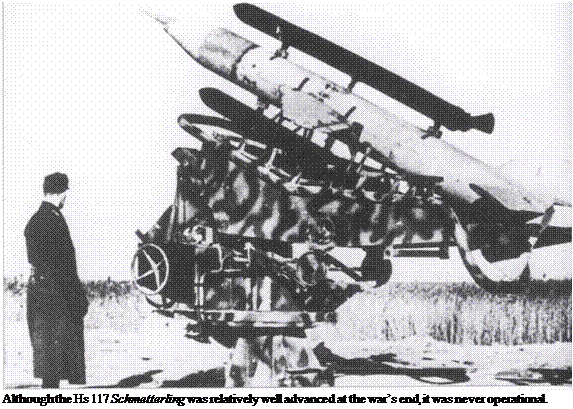Rheintochter
Another flak rocket which failed to meet expectations was the Rheinmetall Rheintochter. Despite great investment and its own test centre at Leba on the Baltic, the rocket was never ready for series production. Early in the autumn of 1941, Generalmajor von Renz, Dr Heinrich Klein (Rheinmetall-Borsig) and the Director of Radar Research at Telefunken, Professor Leo Brand, agreed on an initial specification for a flak rocket. After Goring spoke in favour of subsonic designs on 1 September 1942, Rheinmetall reworked an earlier type (F-Pl) into F-P2 and F-P3, which had an operational ceiling of 18,000 metres (59,000 ft). On 7 December 1943, the HWA awarded Rheinmetall a contract to develop all three versions. In the spring of 1943 the entire project, except for the design office at Leba, was transferred from Berlin to Zittau. By the summer of 1943, several missiles had been built at 1:2.5 scale, all but the first being tested later at Leba using a provisional starting procedure so as to judge how the rocket would fly in practice. On 3 June 1943 Rheinmetall presented its newest designs, R 1 to R 3. Since the manufacturer could not work on all three simultaneously, the RLM favoured for R 3 but Rheinmetall kept working on the others. From December 1943 the R 1 and R 2 versions were test fired at Leba: between February and October 1944 there were 43 test starts in all and some ground trials. Most tests involved the R 1, since R 2 was not yet so far advanced.
An R 3 was first test-fired in October 1944. The prototype had no second- stage motor and served as a test vehicle for the start procedure. Aiter seeing an

R1 demonstrated on 30 October 1944, Goring authorised a continuation of tests in the hope of finding greater efficiency. When on 1 November the 51st solid – fuel R 1 was tested, the R 3 was almost ready. The missile had no cruising motor, since these were far from completion, the thrust jets not having been delivered on time for the first 20 engines. After the liquid-fuel engines designed by Professor Beck of the Technical University were tested and found to be underpowered, the planners fell back temporarily on the solid-fuel alternative.
The next stage of work was discussed at a conference in Karlshagen on 19 November 1944. The endless postponements of set dates and problems with liquid-fuel engines gave a pessimistic oudook on the future. On 18 December the first R3 was fired successfully using a solid-fuel engine. Despite the successful demonstration to the Reichsmarschall, there were still some doubts, and even the super-optimistic Rheinmetall spokesman did not expect even to receive the liquid-fuel engine ordered by the Chief-TLR before the New Year. In mid- January a number of the latest Type HV 10 gyro sets were ordered for Rheintochter testing from February onwards. In January 1945 tests the rocket
flew for 120 seconds. The range was established at 12.7 km (7.9 miles), the operational ceiling 9,650 metres (31,600 ft). By 5 February inclusive, 5 R 3s had been test fired, 51 R Is, and 7 R 2s. Only 24 hours later the Rheintochter project was cancelled by Gruppenfiihrer Kammler since he did not believe it would be ready within a reasonable time.










